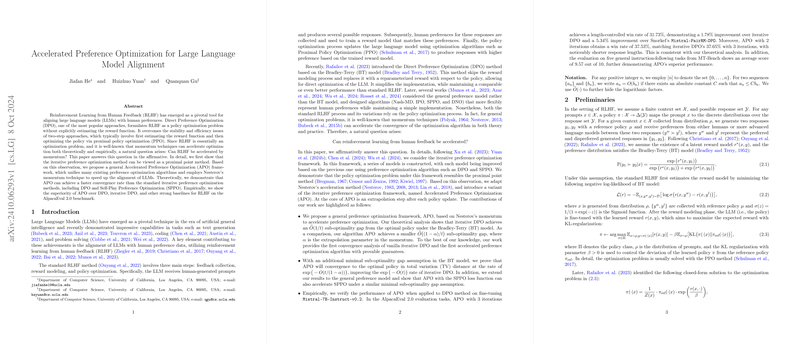Accelerated Preference Optimization for LLM Alignment
The paper "Accelerated Preference Optimization for LLM Alignment" explores the integration of momentum techniques into Reinforcement Learning from Human Feedback (RLHF) to optimize LLMs. The authors propose the Accelerated Preference Optimization (APO) framework, which builds on Direct Preference Optimization (DPO) by incorporating Nesterov's momentum technique to enhance convergence rates.
Key Contributions
The primary contribution of this work is the formulation of a general APO framework that unifies existing preference optimization algorithms, such as DPO and Self-Play Preference Optimization (SPPO). The authors demonstrate both theoretically and empirically that APO achieves faster alignment of LLMs compared to standard iterative preference optimization methods.
Theoretical Insights
The paper rigorously proves that APO can outperform traditional approaches in terms of convergence speed. Theoretical analysis shows that the APO framework achieves a sub-optimality gap of , where is the momentum parameter, compared to the gap of iterative DPO. This advancement is facilitated by modeling the policy optimization process as a proximal point method, seamlessly integrating momentum to expedite convergence.
Empirical Outcomes
Empirical evaluations on the AlpacaEval 2.0 benchmark reveal APO's superior performance over traditional DPO and other baselines. Notably, APO demonstrates significant improvements in preference alignment with a higher length-controlled win rate, achieving a 31.73% rate, surpassing DPO. Further evaluations across multiple tasks from MT-Bench corroborate APO's efficacy, reinforcing its potential in real-world applications.
Implications and Future Directions
This research has profound implications for advancing LLM alignment with human preferences. The integration of momentum techniques in RLHF frameworks may lead to more efficient and effective LLMs, enhancing their applicability across diverse domains. Future work could extend APO to accommodate general preference models beyond the Bradley-Terry framework, and explore adaptive momentum strategies to further refine convergence rates.
Conclusion
The paper presents a compelling case for the use of accelerated optimization methods in the alignment of LLMs. By leveraging momentum techniques, the APO framework sets a new benchmark for efficiency in aligning LLMs with human feedback, offering a promising pathway for future exploration in AI alignment methodologies.
